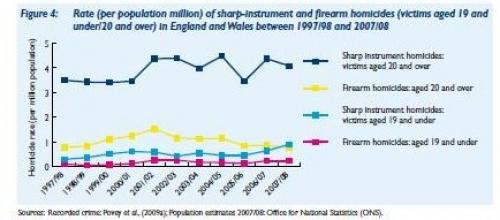A blunt way to cut knife crime
Whichever way you cut it, the Government can’t win over knife crime statistics.
Last December it got into trouble with the Statistics Authority for using unverified NHS data to support a claim that it was making headway against knife crime. Today it published a report on phase one of the Tackling Knives Action Programme (TKAP) that was reported as a failure to achieve its objectives.
“Deaths on the rise as government anti-knife crime strategy fails” said The Guardian. “£7 million anti-knife scheme ‘has not saved one life’” was Metro’s version, while the Mirror, oddly claiming the story as an exclusive, said “Knife killings still on the rise in inner-city areas.”

The Home Office’s report, naturally, is not quite that downbeat. Knife homicides among teenagers in the areas covered by TKAP were unchanged at 23 in the time the scheme was running, between July 2008 and March 2009, as in the equivalent period the previous year. In all age groups there were 126 “sharp instrument homicides” in the TKAP period, against 119 the year before – a small but statistically insignificant increase.
But it’s hard to judge a trend on a single year’s figures, and data from London tended to dwarf that from the other nine police force areas. There is some evidence that violent offences short of homicide involving knives declined in the TKAP areas, but no comparison is offered in the report with trends outside the ten forces involved in TKAP.
So what can be drawn from these figures? As near as dammit, nothing. The report itself comes close to admitting as much, conceding that many of the changes it records probably amount to no more than regression to the mean.
So has the strategy failed, as the headlines allege? If you expected a dramatic drop in homicides in the targeted areas, yes. But who can tell what would have happened without TKAP? Homicides might have risen.
You can’t show a trend without a control group. Statistics of this kind are always lumpy, and no conclusions can be drawn from a single year. Figure 4 from the report (below) shows just how erratic knife homicide statistics are.

Such a lot of effort to prove nothing, one way or the other. But if ministers set up schemes without working out first how they are going to demonstrate success in a statistically convincing way, they deserve all the bad headlines they get.




Phil (not verified) wrote,
Thu, 23/07/2009 - 09:31
It annoys me when MPs repeat the mantra that most victims of knife crime were themselves carrying knives. So they think that if people stopped carrying knives they would stand less of a chance of being stabbed. But surely this is as spurious as claiming that all the victims had two arms - if we cut everyone's arms off then they wouldn't get stabbed either?!
The bottom line is that people carry knives because they're scared or they think it will act as a deterrent from them getting stabbed. If there were more police on the streets they wouldn't have this fear and they wouldn't need the deterrent - but obviously this would cost the government more money.